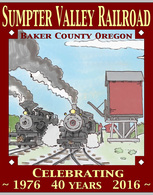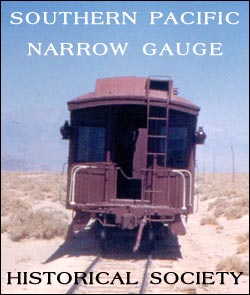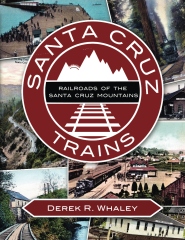

Reference Data.
Incorporated.April 22, 1911
Corporate Ownership.
Watsonville Transportation Co.
1904 - 1908
Watsonville Railway & Navigation Co.
1911 - 1913
Distances.
Watsonville
Port Rogers - 5.3 mi
Equipment Totals.
Electric Interurban - 3
Boxcar - 4
Flatcar - 16
General Office, Power Station and Shops
11 West Third St. Watsonville, Ca
Watsonville Railway & Navigation Co.
By Andrew BrandonF ollowing 5 years of litigation between W. J. Rogers and the shareholders of the Watsonville Transportation Company, the assets of the company were finally sold of to pay off the creditors. The line was reorganized on April 22, 1911 with the purpose to: “rehabilitate, construct, operate and maintain freight service between the City of Watsonville and City of San Francisco by electric railway and steamers.” Lead by F.E. Snowden of Berkeley, a group of local citizens revived the line without the involvement of Mr. Rogers. Immediately thereafter the company began rehabilitation of the right-of-way, pavillion and power plant. President Snowden announced service to the beach would start the next week.
During rehabilitation, a stretch of trackage was abandoned from Main Street to Walker Street, as part of a property dispute between the city and the family of the former Rancho owner who had donated the land when Watsonville was founded in 1870. 1 The company power house, car houses and depot in Watsonville were renovated. Construction of the new concrete wharf was initially contracted to E.W. Hartman of the Marin Concrete Construction Company for $60,000. This wharf was originally intended to be 1,900 feet long, 20 feet wide except for a 44 foot wide, 500 feet long section for the freight warehouse and passing track. For unknown reasons this contract was cancelled and the final design was completed by the San Francisco Bridge Company for $50,000. The final structure was of a more conventional design, utilizing remains of the previous wharf. Extending 1,700 feet into the bay, the first 1,200 feet of the wharf was 24 feet wide, with the remaining 500 feet of length was 60 feet wide to accommodate the warehouse an other structures.
Revitalization continued at Port Watsonville (formerly Port Rogers). Land along the beach adjacent to the wharf was sold by the Pajaro Valley Development Company. F. E. Snowden’s own California Pacific Company acquired additional land and promoted the tent city resort “Calpaco”. The tent city consisted of sixty tents with boardwalks and running water. Snowden even promoted a local baseball team called “Snowden’s Giants”, building the the ball park right along the track at Port Watsonville. To celebrate the opening of the facilities at Port Watsonville and the Baseball field at Beach Park, the citizens of Watsonville put on a May-Day event to honor the officials of the Watsonville Railway & Transportation Co. Operations began using a single motor (the second burned in storage during 1909) and flat cars fixed with benches.2
In December 1912, heavy storms battered the wharf, destroying 160 feet in the process. Faced with $40,000 worth of damage, Snowden took the San Francisco Bridge Company to court to recover the losses claiming faulty construction. Ultimately, Snowden lost in court. After unsuccessfully searching for financial backing to rebuild the line, operations finally ceased in October of 1913. Briefly the Pajaro Valley Consolidated was given permission to haul sugar beets from the junction of the two lines, westward 3 miles towards the ocean, but this operation was short lived. In November John E. Gardner was appointed receiver and scrapping of the line began. Southern Pacific purchased the rails, while the remaining rolling stock was sold elsewhere.
Interest in the line continued into 1915 when a group of local citizens attempted to promote the wharf as a potential location for a Government act to build an up to date port in Monterey Bay. A visit from the Congressional Rivers and Harbor Committee brought favorable comments and a formal survey requested on March 4, 1915. Two reports were produced members of the Corps of Engineers and the Army suggesting five potential locations: Santa Cruz, Port Watsonville, Moss Landing, Capitola and Monterey. Despite being the ideal location to serve the Pajaro Valley's agricultural economy, the reports cited higher costs in rebuilding the wharf to withstand the open sea and the necessity of constructing three breakwaters. On December 18, 1917 the committee made it's decision, selecting Monterey as the site for improvement.3
2. "Port Watsonville Is In Fete Today." San Francisco Call, (CA) May 2, 1912.
3. "65th Congress 2nd Session, December 3, 1917 - November 3, 1918: House Documents Vol. 18" (Government Printing Office, Washington D.C., 1911) Document No. 947.
Bibliography
Fabing, Horace W. "Watsonville Transportation Company", The Western Railroader 29, no. 11 (1966): 1-15.
Fabing, Horace W. and Hamman, Rick. Steinbeck country narrow gauge. Boulder: Pruett Publishing, 1985. ISBN 978-0871086938.
Hilton, George W. (1990). American Narrow Gauge Railroads. Stanford: Stanford University Press. ISBN 0-8047-2369-9.
Reference Material Available Online:
Maps.
Route of the Watsonville Railway & Navigation Co. for Google Earth
By Andrew Brandon
Photographs.
Collected Watsonville Photographs.
Images collected from private collections, libraries and historical societies.



